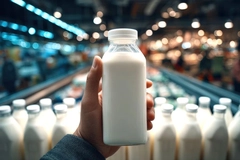F&B packaging innovation stalled? Industrial Physics report tackles structural issues and talent gaps

03 Jun 2024 --- A new report by Industrial Physics examines common organizational factors restricting food and beverage packaging innovation. Compiling insights from 380 packaging decision makers, the analysis reveals only 24% of respondents believe their company is “actively implementing” innovation in packaging.
This contrasts findings from last year’s edition of the “Innovation in Food and Beverage Packaging: Unwrapping the Internal Environment” report, which suggested that 96% of packaging decision makers within the food and beverage space were “pro-innovation” at the time.
The latest report focuses on questions such as: “How do internal factors affect innovation? Is a lack of skills stalling progress? Does innovation differ depending on material type? How are different geographies addressing the challenges?”
“The definition of packaging innovation is definitely different depending on who you speak to within the industry, so there could be an element of manufacturers trialing technologies and process changes to gain efficiencies but not deeming that an innovative approach to their packaging,” says Nash Lawson, global product line director at Industrial Physics.
“However, given the financial scrutiny that the packaging industry is under, the percentages of professionals across those materials who are cutting back or choosing not to innovate is quite understandable.”
 Less than a quarter of food and beverage packaging professionals agree their organization is taking an innovative approach to packaging.Too many cooks in the kitchen
Less than a quarter of food and beverage packaging professionals agree their organization is taking an innovative approach to packaging.Too many cooks in the kitchen
This year’s research highlights that, for many packaging professionals, their company’s ability to respond to innovation “falls short,” with team size and structure among the factors letting them down.
Industrial Physics reports that less than a quarter (24%) of food and beverage packaging professionals agree that their organization is currently taking an innovative approach to packaging.
Meanwhile, half of the respondents (49%) agree that too many teams are involved in the innovation process, which slows them down. Meanwhile, 35% of those using organic material said that they didn’t feel they had the “appropriate expertise” to facilitate growth and innovation in their business.
Additionally, over the past five years, almost half of respondents (47%) said their company has had to make layoffs, with the highest numbers in the US (58%) and those working with paper (62%).
While some may be able to see the benefits of innovation, the report suggests that there “simply isn’t enough justification” to allocate the resource unless a company can guarantee the ROI.
Lawson elaborates: “If a project is going to be undertaken, it’s going to be scrutinized very heavily. Often, if a project is just being pursued to increase the organization’s sustainable credentials, this is not enough to justify the spend.”
However, there appears to be a significant difference in attitudes between those working with different materials. The report indicates that 41% of respondents working primarily in cardboard and 58% working with plastics agreed their organization “would be able to react to innovations.”
The technologies believed to offer the most opportunity to packaging professionals in food and beverage are data acquisition, data analytics and 3D printing.
Defining packaging innovation
Another consideration when examining the data is the subjective nature of defining packaging innovation.
“While for some there is an assumption that innovating in packaging predominantly means using new materials (things that consumers see), or changing the packaging shape to save on transporting costs, for others this could be more to do with the processes in development and manufacturing,” the report discloses.
 Thirty-five percent of respondents working with organic materials state they do not have the appropriate expertise to facilitate growth and innovation.Companies across the food and beverage packaging industry are trialing new production processes to cut down on waste or testing new coatings that are more environmentally friendly.
Thirty-five percent of respondents working with organic materials state they do not have the appropriate expertise to facilitate growth and innovation.Companies across the food and beverage packaging industry are trialing new production processes to cut down on waste or testing new coatings that are more environmentally friendly.
Industrial Physics highlights that while these changes have significant implications, some may not consider them a “packaging innovation” because what is produced “does not look very different.”
In one recent case example, Aimplas developed an edible active coating to slash citrus fruit spoilage throughout the Mediterranean region. The coatings are made from fruit pulp waste, which help reduce fungal rot.
“Despite these considerations, the challenging landscape isn’t all bad news for packaging innovation. Rather, it’s pushing organizations to plan ahead and assess their internal operations to make careful, considered decisions about which innovation opportunities to take,” reads the report.
“However, a company’s internal operations are not the only consideration when examining its likelihood and capability of worthwhile innovation.”
By Benjamin Ferrer











